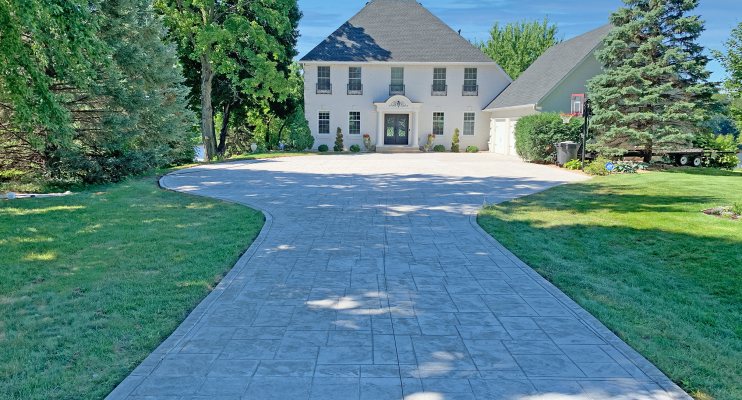Concrete Driveway in Minnesota
When installing a new concrete driveway in Minnesota there are many factors that must be considered. The driveway must be constructed in a way that will last throughout our Minnesota winters. There are steps that need to be taken at the proper time to ensure the longevity of your new driveway. They are: permit, removal, sub-grade, concrete design, curing, and sealing.
Permit
Before the start of constructing your new concrete driveway, some cities required that a building permit be pulled. The main reasons cities require a permit is to ensure that the new driveway does not exceed the allowable width and that the driveway is correctly place on your property in regards to the distance from the side property lines.
Removal of the Old Driveway
Before the removal process begins, all sprinkler heads and other obstructions are clearly marked. If your driveway is to be enlarged, we will mark the grass that needs to be removed. The removal of grass or other organic material is done separately from the removal of the concrete or asphalt driveway because it needs to be taken to a compost site.
The removal process for a tar driveway is less time consuming than the removal of a concrete driveway. Asphalt is generally only two inches thick which makes it easier to tear up and require less trips to the recycling yard. On the other hand, concrete driveways take more time because they are generally four inches thick and have either rebar or wire mesh imbedded throughout. The removal of a concrete driveway is done with a jack-hammer attachment on the bobcat. Some recycling yards charge a fee for dumping concrete that contains rebar or wire mesh.
Evaluate the Sub-grade
Once the driveway is removed the sub-grade is evaluated. Here we are checking for soft spots, un-uniform soil, organic materials, and whether the sub-grade is compactable. If the sub-grade is found to be unsatisfactory, six to eight inches must be excavated out and a class five base material is installed and compacted.
Designing the Concrete Driveway
Concrete driveways in Minnesota must be designed to withstand the freeze/thaw cycles that come with our winters. We achieve this by strictly adhering to three main design features: The concrete strength, an essential additive to the concrete mix, and reinforcement.
- The strength of the concrete must be rated at 4500 psi in 28 days. This mix ensures that the concrete has enough cement paste to strongly bond the aggregates together in the concrete.
- The essential additive is called air entrainment. Air entrainment is microscopic bubbles throughout the concrete mix that act as pressure relief valves for freezing water. Concrete is like a sponge so moisture is present in the concrete year round. When the moisture freezes it needs room to expand without breaking the concrete.
- Reinforcement in concrete driveways is essential because it keeps the concrete sections held together tightly. Concrete driveways are designed to crack in the control joints. Once a crack forms, the slab sections are separated and can become un-level. Reinforcement will prevent this. We have found that the best reinforcement is rebar running in both directions spaced out in three foot intervals like a grid. This will eliminate any wide cracks or slabs becoming un-even.
Control Joints
The old saying goes “there are two types of concrete, concrete that is cracked or concrete that hasn’t cracked yet.” When concrete dries it shrinks. When the concrete is shrinking it is constantly pulling on itself to find an equal balance. Picture in your head a dried mud puddle. To prevent random cracking, control joints are sawed in the day after the concrete is placed (before it completely dries) to dictate where it will crack. Control joints are sawed to a one quarter of the driveway slab thickness which creates straight-line planes of weakness. The crack occurs inside the control joint and is not visible from above.
Curing the Concrete
The hardening of concrete depends on a chemical reaction called hydration. Hydration of cement slows as concrete dries. This is why driveway surfaces must be kept from drying in the first several days after placement. Generally this is not a concern if the air temperature remains below 70 degrees F. There are many methods of curing concrete. One of the oldest methods is keeping the concrete surface wet by spraying water on it. Another method is to apply a curing compound to the surface which creates a water tight membrane to keep the moisture in.
Sealing the Concrete
Concrete driveway surfaces must be allowed to air dry for a period of time after the curing process is complete. We come back 28 days or more and apply a penetrating sealer called siloxane. This sealer penetrates the pours of the concrete creating a watertight surface. It is not a membrane so it does not wear off as quickly as conventional concrete sealers.
For a free estimate on your concrete driveway, please fill out the request a quote form and a representative will contact you shortly.


